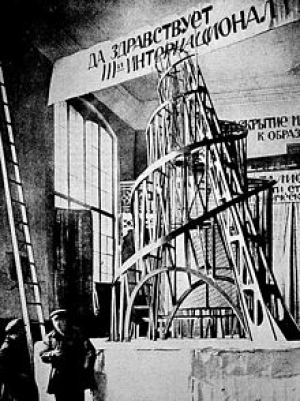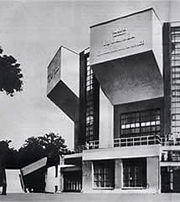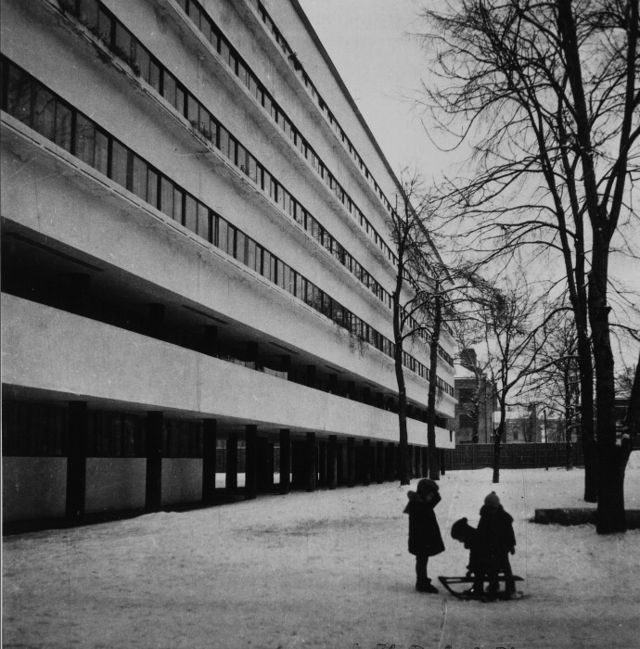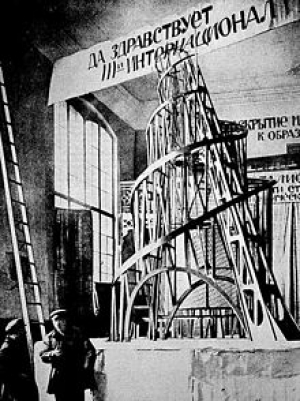
The Russian Revolution and Avant-Garde Architecture
Jean Turner looks at the dramatic changes that took place in architecture following the Bolshevik Revolution, and the profound influence this had on the development of the world's first workers' state.
In the nineteenth century, as in all the other arts, Russians were examining new forms of expression in architecture, following a backlash against Peter the Great’s import of classical architecture to Russia and the rejection of Catherine the Great’s Age of Enlightenment. Designers returned to interpreting traditional Russian forms of building and decoration.
This took place in a fervour of intellectual debate on the correct principles of building. In her book Russian Avant-Garde Catherine Cooke describes the different centres of architectural theory: “[…] the Architecture School of the Imperial Academy of Arts in St Petersburg was a bastion of Classicism but it had two more radical rivals, the architecture department of the St Petersburg Building College and the Royal College in Moscow. In the 1850s and ‘60s it was teachers in these two schools, Apollinari Krasovsky in Petersburg and Mikhail Bykovsky in Moscow, who laid the foundations in Russia for a Rationalist view of architecture rooted in new technologies and social tasks.”
After the assassination of Alexander III by People’s Will (Narodnaya Volya), an authoritarian social order was imposed. However, a new class of industrialist and banking dynasties had arisen from among the freed serfs with strong nationalist and cultural prejudices based on peasant and mercantile values. Their chosen form of design emerged as Moderne, or Art Nouveau, personified by the work of Fyodor Shekhtel.
As in other countries at this time, women were demanding entry to universities to receive architecture training. Since all the colleges were involved in radical unrest against tsarist authoritarianism, it was feared that women, often being supporters of radical workers’ demands, would bring trouble to the universities.
Among five women at the Congress of Russian Architects in 1911, two - Elena Bagaeva and Luisi Molas - ran their own architectural school, using the Academy curriculum and professors from the College of Civil Engineering. In 1902 women’s construction classes were pioneered in Moscow by Ivan Fomin, William Walcot and others, and held at Shekhtel’s office premises. By 1917 women had their own polytechnics in Moscow and Petersburg with full five-year courses in architecture, structural engineering, chemistry and electro-mechanics, and had by decree achieved “the right to erect buildings”. However, the decree was only implemented, along with many other practical and educational freedoms, after the Bolshevik Revolution of October 1917.
The first two decrees of the new Bolshevik Government were the Decree on Peace, which took Russia out of World War I, and the Decree on Land, which nationalised all land and real estate, laying a new and unique foundation for Soviet architecture and planning.
Lenin handed Anatoly Lunacharsky control of the Commissariat of Enlightenment (Narkompros). This shaped a policy of public education, including a planned appropriation of the heritage of the old world alongside the new forms that had emerged in the arts and architecture. This view was later challenged in 1920 by Alexander Bogdanov’s Proletkult which argued that the proletarians themselves would create new forms of culture ab initio.
In November 1917 the Bolshevik Party called a meeting at the Smolny Institute of Petrograd’s progressive younger painters, writers and designers to discuss their potential collaboration with Soviet power. With equal speed, the new Commissariat harnessed the support of the more establishment artists such as Boris Kustodiev, Kuzma Petrov-Vodkin and Alexander Benois, charging them with the preservation of art works in public buildings and with creating a preservation policy for historic buildings.

Ivan Leonidov, model for the Lenin Institute, Moscow, 1927
Rebels such as Vladimir Mayakovsky, Alexander Rodchenko and Lyubov Popova, originally on the fringe of the respectable world of academia, began teaching in art schools and research institutions. The Higher Art and Technical Workshops (VKhUTEMAS) in Moscow produced the artistic movements of Rationalism and Constructivism. The Rationalists focused on aesthetic rationality and form; the Constructivists on technical rationality and science. The Suprematists Ivan Leonidov and Iakov Chernikov favoured individual buildings of an abstract geometric quality on open sites. Classicism was not totally rejected but took new forms, for example in the work of Ivan and Igor Fomin, and Vladimir Shchuko and Vladimir Gelfreikh who designed the Lenin Library.
Much of their first work was theoretical because the five years of civil war and foreign intervention had destroyed the economy. Traditional building industry materials were virtually unobtainable. Models of proposed public buildings and monuments, for example Vladimir Tatlin’s 1919 Monument to the Third Communist International, were produced in the materials available but without any possibility of construction. According to John Milner, Tatlin’s Tower was intended to span the River Neva.

Rusakov Workers' Club, Konstantin Melnikov, 1927-28
During the civil war period, artists, actors and designers were at liberty to create propaganda productions for the new Soviet state. In the words of Alexei Gan, “the whole city would be the stage and the entire proletarian masses of Moscow the performers”. These productions became a focus of revolutionary design. Petrograd held an enormous festival for the first anniversary of the October Revolution that involved eighty-five separate design projects across the city by famous artists and designers, including Nathan Altman who decorated Palace Square with a temporary architectural sculpture.
No major reconstruction could begin until the problem of rapid production of building materials had been resolved. However, these propaganda projects and models were to form the basis of the now famous avant-garde buildings built between 1923 and the 1930s when Soviet architecture influenced the West, rather than vice versa. All were designed by Soviet architects, with the exception of a few by Le Corbusier and Erich Mendelsohn.
The emphasis was on the rapid building of communal housing and services, workers’ clubs, palaces of culture and department stores. These were intended to improve the education and living conditions of the working class and relieve women from domestic work, allowing them to take a full part in industrial production. In the First Five Year Plan (1928–32) top priority was given to building construction to support rapid development in the electrical, iron, steel and transport industries.

Narkonfin, Moisei Ginzburg and Ignaty Milinis, 1930
Many of these iconic buildings are still standing, albeit some in a poor state of repair. However, they remain a tribute to the power of the Marxist-Leninist ideology that produced the world’s first workers’ and peasants’ socialist state, a state that became the patron of modern art and architecture for over seven decades.
This article was first printed in the SCRSS Digest, issue 3, autumn 2017: www.scrss.org.uk/publications.

